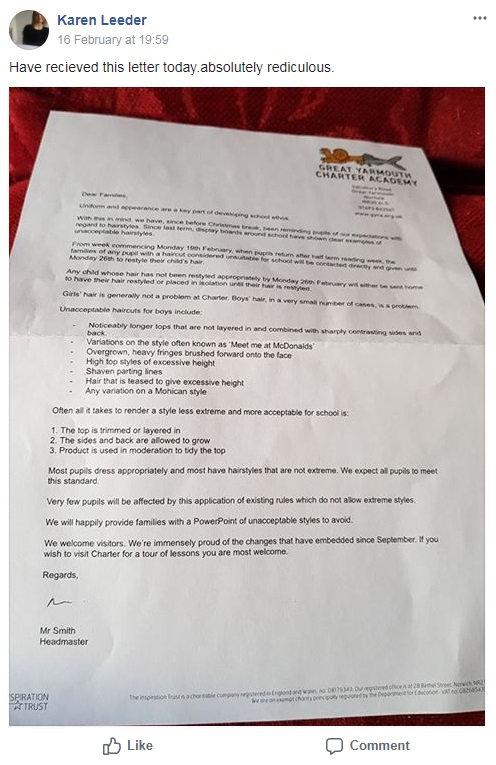A secondary school in Norfolk has made headlines by banning a popular hairstyle known as the “Meet me at McDonald’s” haircut. This trendy, 80s-inspired hairstyle typically features short sides paired with a fluffy, tousled mop of hair on top. The origins of its quirky name remain a mystery, but its popularity among students has prompted a strong response from school authorities.
Recently, Great Yarmouth Charter Academy issued a letter to parents warning that students could be sent home if they arrived at school sporting this high-top hairstyle. The strict ruling has sparked debates among parents and students alike about the appropriateness of such bans in schools.
In the letter penned by headmaster Barry Smith, the “Meet me at McDonald’s” style was listed as one of seven hairstyles deemed unacceptable for boys. Smith clarified that girls' hairstyles generally do not present a problem at the school, raising questions about gender bias in hair policy enforcement.
Understanding the Haircut Ban
The decision to ban the “Meet me at McDonald’s” haircut reflects broader themes in education regarding appearance and discipline. Schools often impose dress and grooming codes to maintain a certain level of decorum and focus on learning. In this case, the school feels that the haircut does not align with their vision of appropriate student appearance.
In his letter, Smith outlined several hairstyles considered unacceptable for boys, including:
- Noticeably longer tops that are not layered and sharply contrasting sides.
- Variations of the “Meet me at McDonald’s” style.
- Heavy fringes brushed forward onto the face.
- High top styles that are excessively tall.
- Shaven parting lines.
- Teased hair for excessive height.
- Any variation of a Mohican style.
Reactions from Parents
The ruling has not gone unnoticed by the parents of students at the academy. Many have taken to social media to express their outrage and disbelief over the strict measures. Critics argue that the ban is an overreach and unfairly targets boys’ hairstyles while sparing girls from similar scrutiny.
Concerned parents, including Sophia Soares and Karen Leeder, have described the ban as “silly” and “unfair discrimination.” They feel that such policies can be detrimental to students' self-expression and individuality.
Background on Great Yarmouth Charter Academy
Great Yarmouth Charter Academy has been in the spotlight for its strict rules, particularly since Barry Smith took over as headmaster. His approach to education has been characterized by rigorous policies aimed at improving student performance, especially following the school’s ranking as the worst secondary school in Norfolk.
In addition to hair policies, Smith has also made headlines for suggesting that students should adhere to strict bedtime routines, which further emphasizes his commitment to discipline within the school environment.

Community Response and Ongoing Debate
As the school community grapples with the implications of this haircut ban, discussions continue about the role of personal expression in educational settings. Many parents have expressed concern over the long-term effects such rules may have on students' self-esteem and mental well-being.
Some have even formed groups on social media like “Yarmouth High Worried Parents,” where they can voice their concerns and share experiences regarding the school’s policies. This growing movement indicates a significant level of concern among parents about the direction the school is taking under its current leadership.
Conclusion
The ban on the “Meet me at McDonald’s” hairstyle at Great Yarmouth Charter Academy is a flashpoint in the ongoing debate about student expression versus institutional discipline in schools. As parents and students navigate these changes, the conversation around appropriate grooming standards and their impact on individual identity is likely to continue.
Ultimately, how schools balance the need for discipline with respect for personal expression will play a crucial role in shaping the educational environment. It is essential to consider the voices of parents, students, and educators alike in finding a solution that respects both individuality and school policies.





